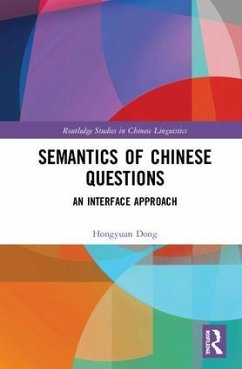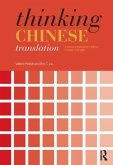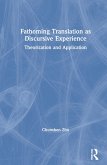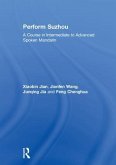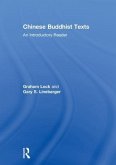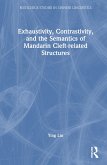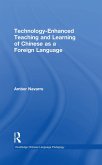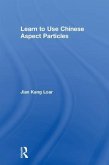- Gebundenes Buch
- Merkliste
- Auf die Merkliste
- Bewerten Bewerten
- Teilen
- Produkt teilen
- Produkterinnerung
- Produkterinnerung
Semantics of Chinese Questions is the first major study of Chinese questions, especially wh-questions, within the framework of Alternative Semantics.
Andere Kunden interessierten sich auch für
![Thinking Chinese Translation Thinking Chinese Translation]() Valerie PellattThinking Chinese Translation175,99 €
Valerie PellattThinking Chinese Translation175,99 €![Fathoming Translation as Discursive Experience Fathoming Translation as Discursive Experience]() Chunshen ZhuFathoming Translation as Discursive Experience169,99 €
Chunshen ZhuFathoming Translation as Discursive Experience169,99 €![Perform Suzhou Perform Suzhou]() Xiaobin JianPerform Suzhou190,99 €
Xiaobin JianPerform Suzhou190,99 €![Chinese Buddhist Texts Chinese Buddhist Texts]() Graham LockChinese Buddhist Texts190,99 €
Graham LockChinese Buddhist Texts190,99 €![Exhaustivity, Contrastivity, and the Semantics of Mandarin Cleft-related Structures Exhaustivity, Contrastivity, and the Semantics of Mandarin Cleft-related Structures]() Ying LiuExhaustivity, Contrastivity, and the Semantics of Mandarin Cleft-related Structures155,99 €
Ying LiuExhaustivity, Contrastivity, and the Semantics of Mandarin Cleft-related Structures155,99 €![Technology-Enhanced Teaching and Learning of Chinese as a Foreign Language Technology-Enhanced Teaching and Learning of Chinese as a Foreign Language]() Amber NavarreTechnology-Enhanced Teaching and Learning of Chinese as a Foreign Language190,99 €
Amber NavarreTechnology-Enhanced Teaching and Learning of Chinese as a Foreign Language190,99 €![Learn to Use Chinese Aspect Particles Learn to Use Chinese Aspect Particles]() Jian Kang LoarLearn to Use Chinese Aspect Particles174,99 €
Jian Kang LoarLearn to Use Chinese Aspect Particles174,99 €-
-
-
Semantics of Chinese Questions is the first major study of Chinese questions, especially wh-questions, within the framework of Alternative Semantics.
Produktdetails
- Produktdetails
- Verlag: Routledge
- Seitenzahl: 196
- Erscheinungstermin: 13. Dezember 2018
- Englisch
- Abmessung: 240mm x 161mm x 15mm
- Gewicht: 464g
- ISBN-13: 9781138496484
- ISBN-10: 1138496480
- Artikelnr.: 54802800
- Herstellerkennzeichnung
- Libri GmbH
- Europaallee 1
- 36244 Bad Hersfeld
- gpsr@libri.de
- Verlag: Routledge
- Seitenzahl: 196
- Erscheinungstermin: 13. Dezember 2018
- Englisch
- Abmessung: 240mm x 161mm x 15mm
- Gewicht: 464g
- ISBN-13: 9781138496484
- ISBN-10: 1138496480
- Artikelnr.: 54802800
- Herstellerkennzeichnung
- Libri GmbH
- Europaallee 1
- 36244 Bad Hersfeld
- gpsr@libri.de
Hongyuan Dong is Assistant Professor of Chinese Language and Linguistics in the Department of East Asian Languages & Literatures at the George Washington University.
List of illustrations
Preface
Acknowledgements
List of symbols
List of abbreviations
Chapter 1 Introduction
1. Main ideas
2. Questions and Chinese questions
3. The meaning of questions
4. Inquisitive semantics
5. Chapter overview
Chapter 2 LF Movement and Binding in Chinese Questions
2.1 Chinese wh-in-situ
2.2 The LF movement theory
2.3 The binding theory
2.4 The status of the particle -ne
2.5 The diachronic semantics of the particle -ne
Chapter 3 Alternative Semantics of Questions in Chinese
3.1 The alternative semantics theory
3.2 Manner and causal wh-questions
3.3 Verbal "zenme" questions
3.4 A-not-A questions
3.5 Alternative questions
3.6 Polar questions
3.7 The grammaticalization of the particle -ma
3.8 Alternative semantics and inquisitive semantics
Chapter 4 Scope Marking of Questions by Phonological Prominence
4.1 Scope marking of questions phonologically in Chinese
4.2 Experimental data for the scope-marking strategy
4.3 Cross-linguistic comparisons of scope marking of wh-questions
4.4 Focus and wh-pronouns
4.5 Scope isomorphism of focus and its computational derivation
Chapter 5 Revisiting the Argument-Adjunct Asymmetry
5.1 Argument-adjunct asymmetry of Chinese wh-in-situ
5.2 The nominal-adverbial asymmetry
5.3 Operator movement and its problems
5.4 A correlational account of island sensitivity
5.5 A phonological reason for adjoining to scope positions
5.6 Island constraints of A-not-A questions explained
Chapter 6 A Distributional Account of Existential Wh-indefinites
6.1 Distributions of interrogative and existential wh-indefinites
6.2 Alternative semantics and existential readings of wh-indefinites
6.3 Syntactic and phonological factors that disfavor existential readings
6.4 Pragmatic reasoning and licensors of existential readings
6.5 Scope variability of Chinese existential wh-indefinites
Chapter 7 Concluding Remarks
7.1 Theoretical contributions of the interface approach
7.2 Limitations and further research directions
Appendix
References
Index
Preface
Acknowledgements
List of symbols
List of abbreviations
Chapter 1 Introduction
1. Main ideas
2. Questions and Chinese questions
3. The meaning of questions
4. Inquisitive semantics
5. Chapter overview
Chapter 2 LF Movement and Binding in Chinese Questions
2.1 Chinese wh-in-situ
2.2 The LF movement theory
2.3 The binding theory
2.4 The status of the particle -ne
2.5 The diachronic semantics of the particle -ne
Chapter 3 Alternative Semantics of Questions in Chinese
3.1 The alternative semantics theory
3.2 Manner and causal wh-questions
3.3 Verbal "zenme" questions
3.4 A-not-A questions
3.5 Alternative questions
3.6 Polar questions
3.7 The grammaticalization of the particle -ma
3.8 Alternative semantics and inquisitive semantics
Chapter 4 Scope Marking of Questions by Phonological Prominence
4.1 Scope marking of questions phonologically in Chinese
4.2 Experimental data for the scope-marking strategy
4.3 Cross-linguistic comparisons of scope marking of wh-questions
4.4 Focus and wh-pronouns
4.5 Scope isomorphism of focus and its computational derivation
Chapter 5 Revisiting the Argument-Adjunct Asymmetry
5.1 Argument-adjunct asymmetry of Chinese wh-in-situ
5.2 The nominal-adverbial asymmetry
5.3 Operator movement and its problems
5.4 A correlational account of island sensitivity
5.5 A phonological reason for adjoining to scope positions
5.6 Island constraints of A-not-A questions explained
Chapter 6 A Distributional Account of Existential Wh-indefinites
6.1 Distributions of interrogative and existential wh-indefinites
6.2 Alternative semantics and existential readings of wh-indefinites
6.3 Syntactic and phonological factors that disfavor existential readings
6.4 Pragmatic reasoning and licensors of existential readings
6.5 Scope variability of Chinese existential wh-indefinites
Chapter 7 Concluding Remarks
7.1 Theoretical contributions of the interface approach
7.2 Limitations and further research directions
Appendix
References
Index
List of illustrations
Preface
Acknowledgements
List of symbols
List of abbreviations
Chapter 1 Introduction
1. Main ideas
2. Questions and Chinese questions
3. The meaning of questions
4. Inquisitive semantics
5. Chapter overview
Chapter 2 LF Movement and Binding in Chinese Questions
2.1 Chinese wh-in-situ
2.2 The LF movement theory
2.3 The binding theory
2.4 The status of the particle -ne
2.5 The diachronic semantics of the particle -ne
Chapter 3 Alternative Semantics of Questions in Chinese
3.1 The alternative semantics theory
3.2 Manner and causal wh-questions
3.3 Verbal "zenme" questions
3.4 A-not-A questions
3.5 Alternative questions
3.6 Polar questions
3.7 The grammaticalization of the particle -ma
3.8 Alternative semantics and inquisitive semantics
Chapter 4 Scope Marking of Questions by Phonological Prominence
4.1 Scope marking of questions phonologically in Chinese
4.2 Experimental data for the scope-marking strategy
4.3 Cross-linguistic comparisons of scope marking of wh-questions
4.4 Focus and wh-pronouns
4.5 Scope isomorphism of focus and its computational derivation
Chapter 5 Revisiting the Argument-Adjunct Asymmetry
5.1 Argument-adjunct asymmetry of Chinese wh-in-situ
5.2 The nominal-adverbial asymmetry
5.3 Operator movement and its problems
5.4 A correlational account of island sensitivity
5.5 A phonological reason for adjoining to scope positions
5.6 Island constraints of A-not-A questions explained
Chapter 6 A Distributional Account of Existential Wh-indefinites
6.1 Distributions of interrogative and existential wh-indefinites
6.2 Alternative semantics and existential readings of wh-indefinites
6.3 Syntactic and phonological factors that disfavor existential readings
6.4 Pragmatic reasoning and licensors of existential readings
6.5 Scope variability of Chinese existential wh-indefinites
Chapter 7 Concluding Remarks
7.1 Theoretical contributions of the interface approach
7.2 Limitations and further research directions
Appendix
References
Index
Preface
Acknowledgements
List of symbols
List of abbreviations
Chapter 1 Introduction
1. Main ideas
2. Questions and Chinese questions
3. The meaning of questions
4. Inquisitive semantics
5. Chapter overview
Chapter 2 LF Movement and Binding in Chinese Questions
2.1 Chinese wh-in-situ
2.2 The LF movement theory
2.3 The binding theory
2.4 The status of the particle -ne
2.5 The diachronic semantics of the particle -ne
Chapter 3 Alternative Semantics of Questions in Chinese
3.1 The alternative semantics theory
3.2 Manner and causal wh-questions
3.3 Verbal "zenme" questions
3.4 A-not-A questions
3.5 Alternative questions
3.6 Polar questions
3.7 The grammaticalization of the particle -ma
3.8 Alternative semantics and inquisitive semantics
Chapter 4 Scope Marking of Questions by Phonological Prominence
4.1 Scope marking of questions phonologically in Chinese
4.2 Experimental data for the scope-marking strategy
4.3 Cross-linguistic comparisons of scope marking of wh-questions
4.4 Focus and wh-pronouns
4.5 Scope isomorphism of focus and its computational derivation
Chapter 5 Revisiting the Argument-Adjunct Asymmetry
5.1 Argument-adjunct asymmetry of Chinese wh-in-situ
5.2 The nominal-adverbial asymmetry
5.3 Operator movement and its problems
5.4 A correlational account of island sensitivity
5.5 A phonological reason for adjoining to scope positions
5.6 Island constraints of A-not-A questions explained
Chapter 6 A Distributional Account of Existential Wh-indefinites
6.1 Distributions of interrogative and existential wh-indefinites
6.2 Alternative semantics and existential readings of wh-indefinites
6.3 Syntactic and phonological factors that disfavor existential readings
6.4 Pragmatic reasoning and licensors of existential readings
6.5 Scope variability of Chinese existential wh-indefinites
Chapter 7 Concluding Remarks
7.1 Theoretical contributions of the interface approach
7.2 Limitations and further research directions
Appendix
References
Index

